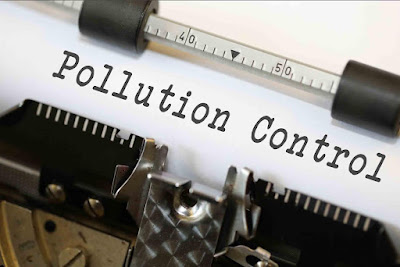Pollution
Pollution, also called environmental pollution, the addition of any substance (solid, liquid, or gas) or any form of energy (such as heat, sound, or radioactivity) to the rate of the environment at a rate faster than it can be dispersed, diluted, decomposed, recycled, or stored in some harmless form. The major types of pollution, commonly classified by environment, are air pollution, water pollution, and land pollution. Modern society is also concerned about specific types of pollutants, such as noise pollution, light pollution, and plastic pollution. Pollution of all types can have negative effects on the effects of human health and well-being.
Pollution of History
Although environmental pollution can be caused by natural events such as forest fires and active volcanoes, use of the word pollution generally implies that the contaminants have an anthropocentric source-that is, a source created by human activities. Pollution has been humanized since the people of first congregated and stayed for any one place. Indeed, ancient human settlements are often recognized by their wastes-shell mounds and rubble heaps, for instance. Pollution was not a serious problem However, with the establishment of permanent settlements by great numbers of people, pollution becomes a problem, and it has remained one ever since.
Cities of ancient times were often noxious places, fouled by human wastes and debris. Beginning about 1000 CE, the use of coal for fuel caused considerable air pollution, and the conversion of coal to coke for iron smelting beginning in the 17th century exacerbated the problem In Europe, from the Middle Ages well in the early modern era, unsanitary urban conditions favored the fertility of population-decimating epidemics of disease, from plague to cholera and typhoid fever. Through the 19th century, water and air pollution and the accumulation of solid wastes were largely problems of congested urban areas. But, with the rapid spread of industrialization and the human population to unprecedented levels, pollution becomes a universal problem.
Control Pollution's
The presence of pollution control Great efforts were made to release the release of harmful substances in the environment via air pollution control, wastewater treatment, solid-waste management, hazardous-waste management, and recycling. Unfortunately, attempts at pollution control are often surpassed by the scale of the problem, especially in less-developed countries. Noxious levels of air pollution are common in many large cities, where particulates and gases from transport, heating, and production accumulate and linger. The problem of plastic pollution on land and in the oceans has grown as a single-use plastics has burgeoned worldwide. In addition, greenhouse gas emissions, such as methane and carbon dioxide, continue to drive global warming and pose a great danger to biodiversity and public health.
plastic pollution
plastic pollution
Plastic pollution, including many single-use plastics like bags and food packaging, in the ocean.
---------------------------------------------------------------------------------------------------------------------
---------------------------------------------------------------------------------------------------------------------
प्रदूषण (पर्यावरण)
प्रदूषण, जिसे पर्यावरण प्रदूषण भी कहा जाता है, किसी भी पदार्थ (ठोस, तरल, या गैस) या ऊर्जा के किसी भी रूप (जैसे कि गर्मी, ध्वनि, या विकिरण) के अलावा इसकी दर से पर्यावरण की दर से अधिक तेजी से फैलने की स्थिति में, पतला, विघटित, पुनर्नवीनीकरण, या कुछ हानिरहित रूप में संग्रहीत। प्रदूषण के प्रमुख प्रकार, आमतौर पर पर्यावरण द्वारा वर्गीकृत किए जाते हैं, वायु प्रदूषण, जल प्रदूषण और भूमि प्रदूषण हैं। आधुनिक समाज भी विशिष्ट प्रकार के प्रदूषकों, जैसे ध्वनि प्रदूषण, प्रकाश प्रदूषण और प्लास्टिक प्रदूषण से चिंतित है। सभी प्रकार के प्रदूषणों का मानव स्वास्थ्य और कल्याण के प्रभावों पर नकारात्मक प्रभाव पड़ सकता है।
प्रदूषण का इतिहास
हालांकि पर्यावरणीय प्रदूषण प्राकृतिक घटनाओं जैसे कि जंगल की आग और सक्रिय ज्वालामुखियों के कारण हो सकता है, प्रदूषण शब्द का उपयोग आम तौर पर इसका अर्थ है कि प्रदूषणों का एक मानवजनित स्रोत है, जो मानव गतिविधियों द्वारा बनाया गया स्रोत है। पहले मंडली और किसी एक स्थान पर रहने के बाद से प्रदूषण का मानवीयकरण किया गया है। वास्तव में, प्राचीन मानव बस्तियों को अक्सर उनके अपशिष्ट-शेल टीले और मलबे ढेर से पहचाना जाता है, उदाहरण के लिए। हालांकि, बड़ी संख्या में लोगों द्वारा स्थायी बस्तियों की स्थापना के साथ, प्रदूषण एक समस्या बन जाता है, और यह तब से एक है।
प्राचीन समय के शहर अक्सर विषाक्त स्थान होते थे, जो मानव अपशिष्ट और मलबे से भर जाते थे। लगभग 1000 सीई की शुरुआत में, ईंधन के लिए कोयले के उपयोग ने काफी वायु प्रदूषण का कारण बना, और 17 वीं शताब्दी में लोहे के गलाने के लिए कोयले के रूपांतरण ने इस समस्या को और तेज कर दिया। यूरोप में, मध्य युग से आरंभिक आधुनिक युग में, विषम शहरी परिस्थितियों में प्लेग से लेकर हैजा और टाइफाइड बुखार तक, जनसंख्या की महामारी की जनन क्षमता को बढ़ावा देता है। 19 वीं सदी के दौरान, जल और वायु प्रदूषण और ठोस कचरे का जमाव काफी हद तक भीड़भाड़ वाले शहरी इलाकों की समस्याएँ थीं। लेकिन, औद्योगिकीकरण और मानव आबादी के अभूतपूर्व स्तर पर तेजी से प्रसार के साथ, प्रदूषण एक सार्वभौमिक समस्या बन जाती है।
प्रदूषण नियंत्रण
प्रदूषण नियंत्रण की उपस्थिति वायु प्रदूषण नियंत्रण, अपशिष्ट उपचार, ठोस-अपशिष्ट प्रबंधन, खतरनाक-अपशिष्ट प्रबंधन और रीसाइक्लिंग के माध्यम से पर्यावरण में हानिकारक पदार्थों की रिहाई के लिए महान प्रयास किए गए थे। दुर्भाग्य से, प्रदूषण नियंत्रण के प्रयासों को अक्सर समस्या के पैमाने से दूर किया जाता है, खासकर कम-विकसित देशों में। कई बड़े शहरों में वायु प्रदूषण का स्तर सामान्य है, जहां परिवहन, हीटिंग, और उत्पादन से कण और गैस जमा होते हैं और भटकते हैं। भूमि और महासागरों में प्लास्टिक प्रदूषण की समस्या एकल उपयोग वाले प्लास्टिक के रूप में बढ़ी है। इसके अलावा, ग्रीनहाउस गैस उत्सर्जन, जैसे मीथेन और कार्बन डाइऑक्साइड, ग्लोबल वार्मिंग को जारी रखते हैं और जैव विविधता और सार्वजनिक स्वास्थ्य के लिए एक बड़ा खतरा पैदा करते हैं।
प्लास्टिक प्रदूषण
प्लास्टिक प्रदूषण
समुद्र में बैग और खाद्य पैकेजिंग जैसे कई एकल-उपयोग वाले प्लास्टिक सहित प्लास्टिक प्रदूषण।














No comments:
Post a Comment